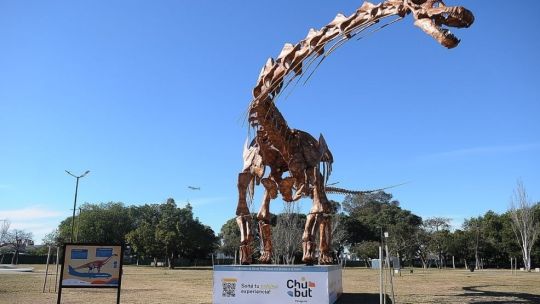
The Buenos Aires City neighbourhood of Recoleta has been invaded by a huge nine-metre-tall, 40-metre-wide monster with sharp teeth.
Take it easy, though – Patagotitan mayorum is a herbivore. During its prime, 101 million years ago, this “record-breaking” dinosaur – the largest identified dinosaur in the world – would wander through what today is the Patagonian steppe. Now the exact replica of its skeleton has been installed at Parque Thays to the surprise and admiration of the little ones and adults alike.
“The idea of installing this replica of the Patagotitan mayorum is to help disseminate palaeontology, especially among children,” said Matias Cutro, speaking for the Museo Egidio Feruglio (MEF) in Trelew, whose collections of over 40,000 pieces of ancient fauna and flora were obtained from rich Patagonian deposits.
Cutro recalled that “when they get to the museum, those who usually know more about the subject are children. And nearly all of them usually say they want to work with dinosaurs. And after they come here, all of them, both children and adults, are fascinated.”
In particular, being the “largest,” this Patagotitan replica was in high demand to be installed and displayed at other museums across the world.
“This and other similar pieces are being exhibited permanently at museums in New York, Chicago and London. We have also sent replicas to travelling exhibits in Spain, Colombia, Brazil and Australia.”
Argentine megadino
“We have solid scientific evidence which leads us to claim that Patagotitan was the largest dinosaur discovered so far on Earth,” palaeontologist José Luis Carballido told Perfil in an interview.
The CONICET researcher and a member of the MEF team specified: “We reached that conclusion after being able to retrieve over 130 bones in good condition, which were buried between rock layers and sediments from the Early Cretaceous era.”
He continued: “In other words, these animals would roam those regions little over 100 million years ago. In this case, based on the testing of bones and their reconstruction, we estimate that these animals were some 40 metres long and nine metres tall. Their neck alone was a dozen metres long. And adult specimens would weigh around 70 tonnes.”
At the site where the remains were retrieved during several digs between 2013 and 2017, experts managed to identify that they belonged to at least six different specimens of the same species.
The striking characteristic of these animals is their large size, which experts highlight by stating that it is larger than a medium-sized aeroplane.
“We believe the large bodies of sauropods (herbivorous dinosaurs with long necks) is related to an evolutionary strategy which helped them to avoid falling prey: the larger the size, the lower their risk of being attacked by a carnivorous dinosaur. Of course, the maximum size they can reach depends on many ecological and physiological variables,” Carballido said.
He also lists certain characteristics of these animals which helped them reach such a size. For instance, a very small head and a very long neck. This enabled them to cover a large foraging area without the need to move their bodies. A logical thing, when considering that moving their over 70,000 kilos meant spending a lot of energy.
What did Patagotitans eat to feed and give energy to such a mass? They would forage foliage, leaves and branches they would break and saw with their sharp teeth and powerful jaws.
Lastly, both experts said: Why visit this and other reconstructions of our world from hundreds of million years ago?
They both answered: “Going to see dinosaurs, visiting a palaeontological museum, knowing how research and reconstruction happen, greatly invites curiosity and a meeting with science which usually leaves a mark.”
The replica factory
Four years ago, the Museo Egidio Feruglio decided to open a very original line to advertise and also raise genuine resources to help them continue to research the past: the “fábrica de dinosaurios or “dinosaur factory.”
According to Cutro: “Oon a site of the Trelew industrial park we installed a high-quality factory of dinosaur replicas, answering to the Museum. Carpenters, blacksmiths, artists and researchers all work there, sometimes in teams of as many as 30 people, who prepare and assemble exact 3D copies of the original skeletons of the different specimens dug up in Patagonia.
“These skeletons can be sold permanently or rented for travelling exhibits. Because this requires the highest scientific and technical specialisation, the Argentine factory today is one of the most prolific and sought-after producers of replicas of this kind in the world.
“They have already made, via different sales and displays, a wide range of replicas of various dinosaurs which have been sold to other museums or rented for tours and exhibitions.”
Not just oil in Añelo
Meanwhile, another group of CONICET researchers presented a new find this week from the department of Añelo, Neuquén Province, where the Vaca Muerta shale formation lies.
The discovery is fossilised remains of a new dinosaur from the rebbachisauridae family, a group of sauropod dinosaurs which lived in the region roughly 95 million years ago. The new species, dubbed Astigmasaura genuflexa, was presented in an article published in the scientific magazine Cretaceous Research.
Astigmasaura was an herbivorous quadruped with a long neck and tail, some 18 metres long and weighing over 10 tonnes.
Flavio Bellardini, a post-doc scholar from CONICET and the first author of the paper, recalled: “This is the first time that the posterior of a rebbachisaurida’s skeleton is discovered, with both rear limbs, hip and the anterior half of the tail perfect preserved. This helps us better understand a part of its anatomy so far unknown.”
related news





